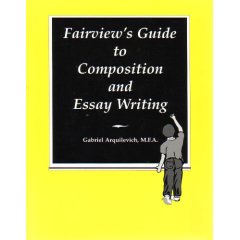Writing for 100 Days

In Writing for 100 Days, individual lessons for 100 days address four areas: composition, fiction, poetry, and writing in action. Assuming the student has a foundation in basic grammar and composition, this book goes on to tackle elements that produce excellent writing. It should work best for high school level students, but many of the lessons could also be used with junior high students. I would begin using some of the lessons for seventh and eighth graders, then go back through many of those same lessons again a year or two later as I use the entire book with older students.
Composition lessons work on both style and grammar by focusing on skills such as word economy, word choice, use of dialect and slang, transitions, sentence variety, use of parentheses and dashes, tone, and organization. The strategy is often humorous; sometimes students are instructed to produce a negative example then a positive example.
In each lesson, instruction is followed by an exercise. Answers to the exercises are provided at the back of the book when appropriate. You need not use all the lessons in order; you can select those that best meet the needs of your students.
The fiction section walks students through the actual writing of a story. Poetry lessons address selected forms such as haiku, limericks, sonnets, and free verse. “Writing in action” lessons tackle a variety of real-life applications such as business letters, writing news reports, conducting an interview, writing a television commercial, technical writing, and travel writing. For fun, a few “word games” are added. A list of additional assignments is provided at the end of the book, but I think students will find some of the lesson activities worthwhile enough to tackle more than once. This means that even though the book is only 103 pages in length, it is packed with so many ideas that it can be used well beyond 100 days. Also, you are free to expand, skip, or repeat lessons as you choose.
Ideally, these lessons should be done in a group. Even two students will do! However, most lessons can be used by a single student working independently as long as there is a parent or teacher to interact with and to evaluate the work. Interaction between two or more students in many of the lessons ranges from helpful to essential, so do try to have at least two students work through the lessons if possible.
This book offers a well-balanced combination of skills instruction, motivation, and practice. I often compare it with Janie Cheaney's Wordsmith: A Creative Writing Course for Young People because it has a similar playful but effective approach to writing for this age level.
Fairview's Guide to Composition and Essay Writing

Fairview's Guide to Composition and Essay Writing is a natural follow-up to use after Writing for 100 Days by the same author. Although lessons cover basic essay structure, they go far beyond the minimal boring essay. Students create a reading journal in which they analyze many types of professional essays. Think of this as you would an artist who learns to paint by studying and analyzing great artists. Students begin to grasp the creative possibilities available to them as they identify effective techniques in these essays.
While Arquilevich covers some of the same territory as do others teaching essay-writing skills, he often uses unusual approaches. For example, in a lesson on paragraphs, he instructs students to, “Find an on-line essay…. After duplicating the essay, have someone eliminate all paragraphs so that it reads as a block. Now, locate the best places for paragraph breaks and compare your choices to the writer's” (p. 15).
You might have noticed that the parent or teacher will likely be the one reformatting the on-line essay into a solid block. Several lessons require either two or more students or else a parent/tutor who will interact with the student on assignments. For example, there is a two-part assignment that requires a writing partner. It says, “First, each person writes one page (any subject) using a lot of qualifiers, intensifiers, informal transitions, and slang. When you're done, exchange papers and rewrite each other's pieces, eliminating the excess. You be the wordsmith and decide what's appropriate” (p. 29).
Fairview's Guide is ideal for small group classes, but it can work with an individual student if a parent or teacher is willing to participate. While some research (e.g., locating professional essays on the internet or in magazines) is required, the lessons are very well explained and easy to follow. Students who meet periodically as a group should be able to work through lessons independently for the most part, bringing their work to exchange or share at class times.
The first half of the book works on preparatory skills such as those mentioned above, plus tone of voice, audience, word choice, use of quotations, and sentence structures. The second half shifts into actual essay writing, tackling four types of essays: argumentative, comparison and contrast, personal, and mock. For the mock essay, students either imitate an established writer's style or pretend to be someone else and create a style reflecting that personality. Each type is thoroughly developed, including a full-length sample essay of each.
An answer key at the back of the book has suggested answers for the applicable exercises. While there are a number of such short exercises, students primarily learn by doing lots of their own writing.
Fairview's Guide can be completed in a year, but it is more important to work through each of the skills, taking as long as necessary. It might be used with advanced junior high students, but it is best for high school level.










